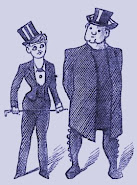NEW YEARS
CELEBRATED
IN THE OLD YEARS!
by Rick Marschall
Cartoonists almost congenitally embrace holidays. Comic artists are inspired by happy events, and in turn inspire their readers. Serious artists and illustrators create commemorations. In general, a job of cartoonists is to celebrate things worthy of celebration.
There is the additional allure of holidays to cartoonists. On those days the artists do not have to scratch their heads quite so much to come up with ideas!
In any (or all) events, here are some New Years themes from Old Years. I have chosen from my collection images that -- by coincidence -- not only raise the glass to the New Year, but appeared in roughly "round number" years ago (unless you are reading this as an archive post...!)
(Above) Winsor McCay, as "Silas," drew this fanciful exception to my rule here. At the end of 1907 he drew this strip of Father Time replacing the old 1907 with a baby 1908. Where did Old Man 1907 reside? In a grandfather's clock, of course! This appeared in the New York Telegram.
We will proceed chronologically. One hundred fifty years ago, the Father of American Editorial Cartooning, Thomas Nast, introduced the New Year in his short-lived magazine Nast's Almanac.
Ten years later in Puck Magazine this greeting appeared. The drawing by Friedrich Graetz, an Austrian cartoonist who worked in the US for three years, is an original in my collection.
The prolific Dwig (Clare Victor Dwiggins) created dozens of strips from the Turn of the Century into the 1950s; and many hundreds of comic postcards in the century's first decade. This was sent in 1910.
Almost a hundred years ago, in 1920, someone received this charming New Year card drawn by the amazing cartoonist Rose O'Neill (happy-spoiler alert: A major treatment of her life and work is in the works for the imminent arrival of NEMO Magazine!)
Also from my collection (on the wall, as you can see, of the Gibson Room in my house) from one century ago -- Charles Dana Gibson drew Life's cupid (mascot of his magazine, Life) toasting the baby cupid with the sash labeled "1925." This appeared as a cover of Life, and was then inscribed to Gibson's niece.
The lone New Years cartoon sans smiles is also from the mid-1920s, by John Held Jr. Hoping that your own celebrations do not result in headaches -- nor, in fact, may any other activities in the upcoming Twelvemonth, we wish you a...
HAPPY
NEW
YEAR!
































































